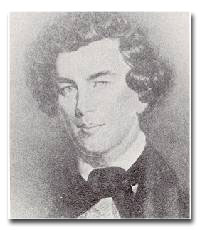GREAT CITIZENS - WILLIAM MARSH RICE
 About the same time Sam Houston was completing his first term as president, William Marsh Rice arrived in Houston. Rice was born in Springfield, Massachusetts on March 14, 1816 to Patty (Hall) and David Rice. His father, a skilled Mechanic at the government gun plant in Springfield, had invented the Rice Musket.
About the same time Sam Houston was completing his first term as president, William Marsh Rice arrived in Houston. Rice was born in Springfield, Massachusetts on March 14, 1816 to Patty (Hall) and David Rice. His father, a skilled Mechanic at the government gun plant in Springfield, had invented the Rice Musket.
The eldest of ten children, Rice attended public schools in Springfield as well as the Wesleyan Academy in nearby Wilbraham. After working for a year as a clerk in a grocery store, he operated his own country store, bought for him by his father. Within two years, Rice accumulated some $2,700 in profit and left New England to make his fortune in the new nation of Texas.
He arrived in Houston almost penniless, after losing most of his belongings at sea. An industrious, ambitious man, Rice was undaunted and began to work as a store clerk. Within a few years, he had recouped his losses, entered into a partnership with Ebenezer B. Nichols and opened a general merchandise store, which they named " Rice and Nichols, Importers and Wholesale Grocers."
Among other ventures, Rice, like Nichols, became involved in transportation. He founded the Houston and Galveston Navigation Company, which later became the Houston Navigation Company, and was instrumental in the development of the Buffalo Bayou Ship Channel.
On July 4, 1850, Rice married eighteen-year-old Margaret C. Bremond. In 1853, they purchased a home, built by Nichols some three years earlier, located at the corner of San Jacinto and Congress streets, opposite Courthouse Square.
Mrs. Rice died on August 16, 1863. It is believed that following the funeral service in their home, Rice never returned to live in it. Instead he departed to Mexico and little is known of this period of his life. It is known, however, that Rice left Texas as a wealthy man, for, by the time the Civil War broke out, his fortune was estimated at about three-quarters of a million dollars.
In 1891, Rice established an initial endowment of $200,000 for the Rice Institute. His intention, he said, was to give the new institution a firm financial foundation, and he stated: " Texas received me when I was penniless, without friends or even acquaintances, and now in the evening of my life, I recognize my obligation to her and to her children. I wish now to leave to the boys and girls struggling for a place in the sun the fortune I have been able to accumulate."
Lengthy litigation initiated by his second wife's relatives after her death in 1896 delayed the realization of Rice's dreams. His own murder four years later further delayed the plan.
The murder of Rice on September 23, 1900 in his New York City apartment was one of the most widely publicized crimes in the nation's history. A sensational trial revealed that he was killed by Charles Jones, his valet, who used chloroform to ensure that Rice, approaching his eighty-fifth birthday, would not wake up from his sleep. The courts later found that Albert P. Patrick, attorney for Mrs. Rice's relatives, conspired with the valet to kill Rice and, by using a fake, so-called "New York will," sought to become the primary beneficiary of his fortune. The truth came to light, and since Rice left the bulk of his vast estate to the William M. Rice Institute for the Advancement of Literature, Science and Art, his dream was fulfilled. By the time the institute opened in 1912, the endowment had grown to seven million dollars and, at its inception, Rice Institute was among the wealthiest universities in the United States.






